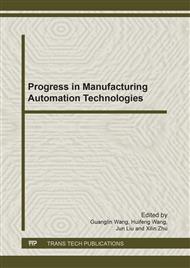p.57
p.61
p.65
p.69
p.75
p.80
p.88
p.92
p.96
Hierarchical Structure Model of High Speed Milling Hardened Steel
Abstract:
In high speed milling hardened steel, cutting performance of cutter is uncertainty because hardness distribution and machining elements change. Based on the experiments of high speed milling hardened steel, the interaction among cutting force, cutting temperature, cutting vibration, processing surface quality and machining efficiency is investigated by means of interpretative structural modeling method, hierarchical structure model in high speed milling hardened steel is founded, optimization design method of high speed milling performance is proposed. Results show that uneven distribution of hardness swells the interaction of machining elements, and causes cutting vibration and processing surface quality mutations. Hierarchical structure model reveals the relationship between control variables and performance index in high speed milling hardened steel, it helps optimization of process parameters, restrains cutting vibration in high speed milling automobile mould, and improves processing surface quality and machining efficiency.
Info:
Periodical:
Pages:
75-79
Citation:
Online since:
July 2011
Authors:
Price:
Сopyright:
© 2011 Trans Tech Publications Ltd. All Rights Reserved
Share:
Citation:


